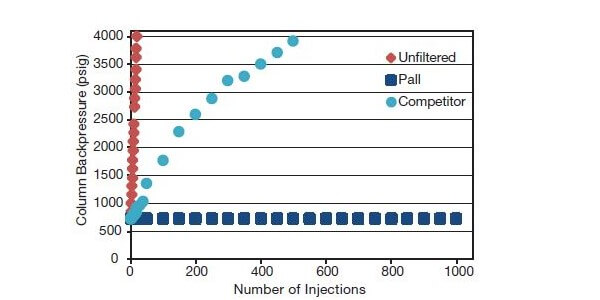In many laboratories, the need to consistently generate high quality data means that laboratory managers and technicians need to ensure their instruments are performing optimally around the clock. Filtration of both the sample and mobile phase prior to analysis helps increase the lifespan of chromatography columns, reduces overall instrument wear, and removes any particles that may interfere with the chromatogram.
Accurate, reproducible data depends upon proper HPLC column performance. Injecting samples containing particulates will eventually block the column inlet and column packing, causing high column back-pressure and shortening the normal service life of the column(1). Plugging of the HPLC column by particulate matter is the most frequent cause for column failure encountered by analysts. Sample filtration using syringe filters with 0.45 μm (HPLC) or 0.2 μm (UHPLC) pore size membranes, is a time effective and easy to implement method to protect the column. As we have shown previously(1) and depicted in Figure 1, filters with the same nominal rating can vary drastically in their capacity to provide column protection. In fact the Pall Acrodisc One syringe filter extends column life up to at least 52 times over unfiltered samples.
 Figure 1. Effects of filters on HPLC column life following injections of unfiltered and filtered 0.05% latex sphere suspensions(1). With unfiltered samples, the column failed due to plugging after 19 injections. Samples passed through low cost hydrophilic PTFE syringe filters plugged the columns after 500 injections. No increase in backpressure was observed after 1000 injections of samples filtered with Pall Acrodisc One syringe filters with wwPTFE membrane.
Figure 1. Effects of filters on HPLC column life following injections of unfiltered and filtered 0.05% latex sphere suspensions(1). With unfiltered samples, the column failed due to plugging after 19 injections. Samples passed through low cost hydrophilic PTFE syringe filters plugged the columns after 500 injections. No increase in backpressure was observed after 1000 injections of samples filtered with Pall Acrodisc One syringe filters with wwPTFE membrane.




